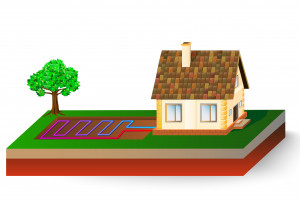Recently I was asked to speak at the Rensselaer Renewable Energy & Sustainable Living Fair in New York, which took place on October 20, 2018. I was introduced to Frank Na...
Piping Heat into the Pool
Pools are almost a necessity for many homes, and certainly for resorts and hotels. It’s not uncommon for pools in recreational centers to expend $50,000 per year for fuel to heat a pool. The typical methods by which a pool is normally heated include:
- Fossil fuel (combustion heat)
- Solar collectors (solar-thermal)
- Electric resistance
- Heat pump (either “air sourced” or “geothermal sourced”)
Fossil fuel heating for pools and spas is an old favorite. First cost is relatively low, but that comes at a higher price environmentally (high greenhouse gas or “GHG” emissions) and depending on the fuel source, it can cost quite a bit of money.
The most energy efficient and renewable source for pool heating is solar-thermal, but solar is dependent upon the cooperation of the weather. Cloudy and cool days can mean a cold pool, and may require need for backup heating sources much of the year.
Electric resistance heating consumes electricity as it heats up electrodes or heating elements over which the water passes, providing a clean and safe water heating alternative, but resistance heating can be pretty expensive (energy-wise). Using the Coefficient of Performance (COP) rating system for heating equipment, electric heating has a COP of 1.0, meaning that 1 unit of heat is provided for each unit of electricity, a one-to-one ratio, or 100% efficient in the COP rating system.
Air source heat pumps designed for pool heating use outside air, pumping heat out of the ambient air into your pool or hot water tank. However, they too rely somewhat on cooperative weather conditions, that is; air temperatures being warm enough to facilitate efficient extraction of heat to transfer to potable water and/or pool heating needs. Air source heat pump efficiencies are in the 3.0 COP ranges (300% efficient).
Water source equipment provides the only reasonable way to capture waste heat. The rejected heat from a water sourced heat pump may easily be made available to other systems in need of heating BTUs, especially a swimming pool. This can be accomplished passively through an exchanger, or actively through a pool heat pump.
Passive Pool Heating
As viewed in the schematic, the condensor water may be run through an exchanger installed in the pool-water circuit, allowing the pool water to pick-up the heat being rejected from the home or business (such as a resort or hotel with a pool). The process serves to provide passive heating of the pool, and increases the efficiency of the water-source heat pumps or chillers.
Active Pool Heating
For active heating of swimming pool and spa the best scenario is attained with a geothermal, or “water-to-water” heat pumps, pulling heat from a dependable, renewable energy source; the earth. Geothermal heat pumps can be about 5.0 COP (500% efficient). When tied in to a common condensor water loop, efficiency can go up.
Stop Paying Twice to Move Energy
While your customer is paying for electricity to power their HVAC cooling system, they are also providing for the energy to run computers, lighting, blow dryers, ovens, and domestic water heating. The HVAC system uses power to remove the heat created by all of these internal gains on top of the occupant loads. They are actually paying for energy twice to remove this waste heat through the process of cooling their house. When the energy is transferred to a pool, spa, or domestic hot water (DHW) system, the removal of heat from the building for HVAC provides real work that may be put to good use.
Whether the heat pumps and chillers are on a geothermal loop or a cooling tower, the benefits a customer receives from a water sourced system include the ability to channel and use this waste heat energy. The heat is entrained in the discharge water line. Most manufacturers of geothermal heat pumps even have a factory installed hot water generator available. This option gives you two extra connections labeled DHW (Domestic Hot Water) “In” and “Out” that may be connected to most any hot water tank, and the geothermal heat pump can turn waste heat into usable hot water.
There are thousands of geothermal heated pools around in the US. There is a good chance that the local YMCA, hotel, health club or community pool near you already has geothermal sourced pool heating. Surprisingly, many of these still have air sourced cooling systems that could be converted to water sourced geothermal during the normal course of HVAC equipment attrition and upgrade (another opportunity for income for plumbing and heating contractors!).
Why not show you customers how they can stop paying two and three times to move energy, and share the loads in their homes and businesses; show them how you can help them to enjoy the savings of thermal load sharing with a geothermal HVAC system.
Contact the International Ground Source Heat Pumps Association (IGSHPA) to find out more, and become a member of the Geothermal Exchange Organization (GEO).
— Greg Cunniff is the Manager of Application Engineering at Taco, and co-wrote the McGraw-Hill textbook, “Modern Geothermal HVAC Engineering and Controls Applications”. He can be reached at [email protected].
— Jay Egg is a geothermal consultant, writer, and the owner of EggGeothermal. He has co-authored two textbooks on geothermal HVAC systems published by McGraw-Hill Professional. He can be reached at [email protected].
Leave a comment
Related Posts

Since we work in a metropolitan area, the loop field can be a challenge at times. As we sub this part of the job out to a well driller, it can be more of a challenge, as ...

When I started my company ten years ago, I wanted to focus on radiant floor systems and mechanical systems for large custom homes. By and large, I have been successful in...